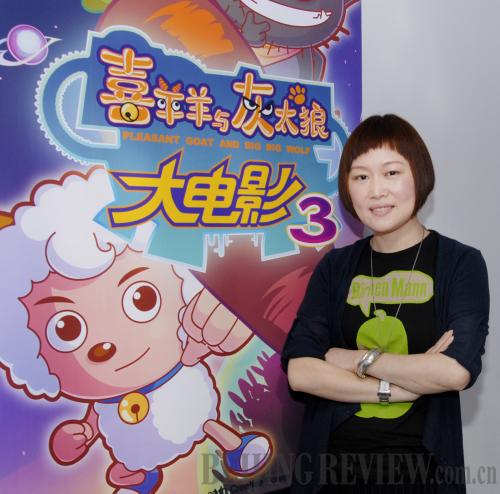|
 |
|
Liu Manyi, General Manager of Creative Power Entertaining (JING XIAOLEI) |
Story ideas mostly come from the writers' real life experiences or their childhood memories. They also take stories sourced from the Internet and often consult kids about what they'd like to see in the series, Shao said.
With these raw ideas, the writers try to add a moral message to the basic story structure. But to produce content that is truly interesting to children, the writers must think like children. Throughout the production of the cartoon series, the writers took lessons in child psychology taught by renowned field experts.
"It seems that the simplest story is the hardest to write," Shao said. "Every day my son watches Teletubbies, and every episode looks the same to me, but kids can see the difference."
The team of writers, with an average age of about 25, wanted to make the cartoon as fun and full of humor as possible to avoid being classified with conventional Chinese cartoons that are too serious or full of "preaching," Shao said.
"One of the most important things we've learned from our Western counterparts in Hollywood is how to tell a good story," Shao said, adding that kids today are more difficult to entertain than those born in the 1970s or the 1980s. "Kids today don't buy into all the preaching stuff. They'll run away and never want to watch your cartoon again if you preach too much."
But an interesting story idea doesn't just come to fruition on its own, or from any one person. Brainstorming sessions, as Shao describes them, usually start with calm discussions, escalate into loud shouting matches and result in a great story idea.
"The company to me is like a big family, or a school. We share the same interests and we're always learning from each other," said Zhang Heng, 28, who is one of the company's animation directors and was involved in the first 40 episodes of the Pleasant Goat series. And in Zhang's eyes, many of his colleagues are "kidults," or adults that are children at heart. "I still like cartoons and comics. I also stay in touch with kids from the neighborhood and with some primary and middle school students. Sometimes they give me inspiration for my work."
From rough sketch to final print
Despite the fan fervor around Pleasant Goat and Big, Big Wolf, this new animated series isn't China's first cartoon success story. The 1960s were a heyday for Chinese cartoons, with Monkey Makes Havoc in Heaven, derived from the Chinese literary classic Journey to the West, a folk favorite.
"Monkey Makes Havoc in Heaven is a Chinese cartoon classic. It's actually had some influence on me as well. But it took the whole strength of the nation and many artistic masters to make that cartoon in the 1960s," said Shao, adding that Creative Power Entertaining is trying to build up an animation industry, not just to make an animated masterpiece.
However in the following years home-made cartoons failed to satisfy Chinese audience who grew accustomed to watching imported animated films and shows, especially Japan's Astro Boy, which, China purchased in 1981, was the most popular children's cartoon of its time.
By the 1990s, foreign animation had all but wiped out domestic animation studios—at the time, domestic animation works represented 10 percent of the whole.
"Several years ago, there was a saying in China that if you enter the animation business you'd better be willing to burn money, because it was a loss-making industry. That's why we started off making low-budget and low-technology animation works like Pleasant Goat and Big, Big Wolf which only requires flash technology," noted Liu.
A turning point for the Chinese animation industry finally came in 2004. The State Administration of Radio, Film and Television (SARFT) issued a document ordering more than one third of the country's provincial and sub-provincial TV stations to have children's channels. Domestic animation productions must make up at least 60 percent of all animation broadcasting time every season. This requires the TV stations to have 280,000 minutes of animation time, but in 2004, that time totaled a mere 21,800 minutes. That's where Creative Power Entertaining saw an opportunity and stepped in.
But the market was cruel, said Zhang, because most children preferred foreign cartoons as they were more entertaining. Chinese enterprises, which were focused on short-term profits due to insufficient capital funds, emphasized quantity over quality, and as a result their productions left much to be desired.
The huge success of Pleasant Goat and Big, Big Wolf has changed that trend and set a good example of how quality productions can win viewers and a larger share of the animated market.
China must also overcome another obstacle hindering its animation industry: piracy.
"Almost 90 percent of the cartoon derivatives in the market, like dolls, lunchboxes and other products, are pirated. But we can do little to stop this," said Liu.
Liu also stressed that if the Chinese animation industry is going to grow to compete against foreign studios, the most urgent task is recruiting creative talent.
"We lack the kind of talent in creation and marketing. Many college graduates have a lot of skills, but little creativity," Liu said. To cultivate this talent, Creative Power has cooperated with local universities to incorporate animation and related skills into their curriculums to train future animation artists for the next generation in Chinese animated films and TV shows. | 